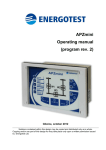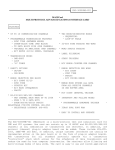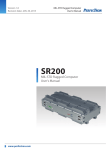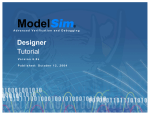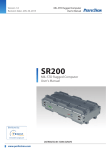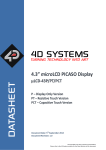Download Merrick3 User Manual Issue – 1.0
Transcript
Merrick3 User Manual Issue – 1.0 © Enterpoint Ltd. – Merrick3 Manual – Issue 1.0 02/11/2011 11 Kit Contents You should receive the following items with your Merrick3 development kit: 1 - Merrick3 Board 2 - Programming Cable Foreword PLEASE READ THIS ENTIRE MANUAL BEFORE PLUGGING IN OR POWERING UP YOUR MERRICK3 BOARD. PLEASE TAKE SPECIAL NOTE OF THE WARNINGS WITHIN THIS MANUAL. Trademarks Spartan-6, ISE, Webpack, EDK, COREGEN, Xilinx are the registered trademarks of Xilinx Inc, San Jose, California, US. Merrick3 is a trademark of Enterpoint Ltd. © Enterpoint Ltd. – Merrick3 Manual – Issue 1.0 02/11/2011 22 Contents Kit Contents Foreword Trademarks MERRICK3 BOARD INTRODUCTION MERRICK3 FEATURES FPGAs CONNECTIONS BETWEEN FPGAS 1. Between Communications FPGA and Control FPGA 2. Between Control FPGA and Array FPGAs 1 Patch bus signals 2. Clock Signals 3. Configuration signals 4. Individual FPGA Patch Signals 3. Between Communications FPGA and Array FPGAs 4. Between Adjacent Array FPGAs 5. Between the Control FPGA and the Expansion connector DEVICE ID CODES SPI FLASH DDR3 MEMORY LEDS PCIE INTERFACE BATTERY MICRO SD CARD HOLDER CLOCK GENERATOR INPUT POWER CONNECTIONS HEAT SINKS POWER REGULATORS PROGRAMMING MERRICK3 MECHANICAL Medical and Safety Critical Use Warranty Support © Enterpoint Ltd. – Merrick3 Manual – Issue 1.0 02/11/2011 2 2 2 4 5 6 7 8 8 8 8 9 10 12 14 15 18 20 21 23 24 27 27 28 29 30 30 31 32 35 36 36 36 33 MERRICK3 © Enterpoint Ltd. – Merrick3 Manual – Issue 1.0 02/11/2011 44 Introduction Welcome to your Merrick3 board. Merrick3 is a Spartan-6 based FPGA development board offering a highly powerful approach to prototyping FPGA and System designs. Merrick3 is a product for the high performance computing (HPC) marketplace. Based on an array of 24 XC6SLX150 FPGAs and 16 DDR3 this board delivers algorithm processing up to 10000X that of a X86 processor whilst operating with a power envelope of between 10-200W. In addition the board features high speed routing across the array and array reload (under 0.25 seconds), a board stacking interface and a PCI-E interface. We are also able to provide a separate algorithm implementation service for customers. Merrick3 also offers a highly powerful approach to prototyping FPGA and System designs. The aim of this manual is to assist in using the main features of Merrick3. There are features that are beyond the scope of the manual. Should you need to use these features then please email [email protected] for detailed instructions. Merrick3 is currently fitted with XC6SLX150-2FGG484C Spartan-6 devices. Other variants may be offered at a later date or as an OEM product. Please contact us on [email protected] should you need further information. © Enterpoint Ltd. – Merrick3 Manual – Issue 1.0 02/11/2011 55 Merrick3 Features FPGA Left Array Bank Memory Card Holder 2 GBit ddr3 serving communica tions FPGA 2x128Mb SPI Flash memory Clock Generator Expansion/stacking interface PCIE Control FPGA Interface XC6SLX150T Communications FPGA XC6SLX45T 12 xc6slx150csg484 devices per bank 2 GBit ddr3 serving control FPGA FPGA Right Array Bank 8x2 GBit DDR3 per FPGA bank Your Merrick3 will be supplied un-programmed. Unless you have bought an OEM product your board will be supplied with either a Prog2 parallel port programming cable or a Prog3 USB port programming cable. The Spartan-6 FPGAs on the standard Merrick3 board are not supported by the free Webpack version of ISE. You will need version 11.1 SP4, or later, of the ISE tools, which are available from Xilinx at www.xilinx.com. © Enterpoint Ltd. – Merrick3 Manual – Issue 1.0 02/11/2011 66 FPGAs Top Row Centre Row Bottom Row Communications FPGA 12 Left Array FPGAs Control FPGA 12 Right Array FPGAs Merrick3 has a total of 26 FPGAs. There are 24 array FPGAs, one Control FPGA and one Communications FPGA. The standard arrangement is: Communications FPGA – XC6SLX45T-FGG484C Control FPGA – XC6SLX150T-FGG900C Array FPGAs - XC6SLX150-CSG484C Merrick3 is normally available with commercial grade -2 speed devices fitted in the XC6SLX150 size. Should you have an application that needs different size FPGAs, industrial specification parts or faster speed grades please contact us for a quote at [email protected]. The Merrick3 FPGAs are highly interconnected. The diagram below shows the major sets of interconnections: Fig1 Merrick major interconnections © Enterpoint Ltd. – Merrick3 Manual – Issue 1.0 02/11/2011 77 CONNECTIONS BETWEEN FPGAs 1. Between Communications FPGA and Control FPGA There are 20 connections between the Communications FPGA and the Control FPGA, arranged as 10 pairs between 3.3V IOs. The table below shows the pin connections: SIGNAL NAME COMMS_BUS1 COMMS_BUS2 COMMS_BUS3 COMMS_BUS4 COMMS_BUS5 COMMS_BUS6 COMMS_BUS7 COMMS_BUS8 COMMS_BUS9 COMMS_BUS10 COMMS_BUS11 COMMS_BUS12 COMMS_BUS13 COMMS_BUS14 COMMS_BUS15 COMMS_BUS16 COMMS_BUS17 COMMS_BUS18 COMMS_BUS19 COMMS_BUS20 COMMUNICATIONS FPGA J3 J1 F3 E4 D2 D1 G3 G1 J4 H3 H2 H1 C1 B1 H4 G4 K2 K1 E3 E1 CONTROL FPGA V26 V27 R21 R22 R24 R25 T28 T30 U27 U28 U29 U30 R27 R28 T26 T27 Y24 Y25 T24 T25 2. Between Control FPGA and Array FPGAs There are a total of 4 sets of connections between the control FPGA and the array FPGAs. 1. PATCH BUS SIGNALS There are 120 connections shown in the diagram above (fig1) arranged as 20 signals (10 pairs) each to the nearest FPGA in each row. The connections are shown in the table below. In the schematics and .ucf file these connections are called, for example, PATCH_LH1BUS(1 to 20) for the 20 signals connected to the 20 RBUS signals on the top left row FPGA nearest to the Control FPGA and PATCH_RH3BUS(1 to 20) for the 20 signals. connected to the 20 LBUS signals on the bottom right row FPGA nearest to the Control FPGA. These connections are between IOs operating at 3.3V. © Enterpoint Ltd. – Merrick3 Manual – Issue 1.0 02/11/2011 88 SIGNAL NUMBER LEFT TOP ROW 1 2 3 4 5 6 7 8 9 10 11 12 13 14 15 16 17 18 19 20 AB10 AB9 AC11 AD11 AA11 AB11 AE13 AF13 AC15 AD15 AD14 AE14 Y15 AA15 AB17 AD17 AB13 AC13 AE17 AF17 LEFT CENTRE ROW AD12 AE12 AB14 AC14 AJ15 AK15 Y16 AB16 AJ17 AK17 AH16 AK16 AD18 AE18 AA18 AB18 AF16 AG16 W20 Y20 LEFT BOTTOM ROW AA19 AB19 AC19 AD19 AD20 AE20 AB21 AC21 AE23 AF23 AA22 AC22 AE24 AF24 AF25 AG25 AD22 AE22 AD24 AC24 RIGHT TOP ROW D6 C6 E7 D7 F8 E8 K10 J10 L12 K12 H11 G11 M13 L13 J13 H13 J12 H12 L14 K14 RIGHT CENTRE ROW G14 F14 F15 E15 B15 A15 H17 G17 C16 A16 E16 D16 B17 A17 G18 F18 H16 G16 L17 K17 RIGHT BOTTOM ROW G20 F20 K20 J20 L21 K21 G22 F22 J22 H22 F24 E24 D24 C24 B25 A25 F23 E23 E25 D25 2. CLOCK SIGNALS There are also 4 clock signals (2 pairs operating at 3.3v) which connect between the Control FPGA and global clock pins on the Array FPGAs. Each set of 4 clock signals is routed to a row of 4 FPGAs. The connections to the array FPGAs are shown in the table below: © Enterpoint Ltd. – Merrick3 Manual – Issue 1.0 02/11/2011 99 SIGNAL NAME ARRAY FPGA PIN CLK1 CLK2 CLK3 CLK4 B10 A10 C11 A11 The connections to the Control FPGA are shown in the table below. In the schematics and .ucf file these connections are called, for example, CLOCKS_LH1_(1 TO 4) for the 4 signals connected to the CLK(1 TO 4) signals on the four top left row FPGAS and CLOCK_RH3_(1 to 4) for the 4 signals connected to the CLK(1 TO 4) signals on the four bottom right row FPGAS. ARRAY SIGNAL NAME CLK1 CLK2 CLK3 CLK4 LEFT TOP ROW AC3 AC1 AB4 AB3 LEFT CENTRE ROW AD7 AE7 AB7 AB6 LEFT BOTTOM ROW AC28 AC27 AE25 AE26 RIGHT TOP ROW N5 N4 J5 J4 RIGHT CENTRE ROW T9 T8 P7 P6 RIGHT BOTTOM ROW N27 N28 N29 N30 3. CONFIGURATION SIGNALS There are 23 configuration signals routed along each block of 4 FPGAs, with an individual Chip Select signal to each FPGA. This is to enable the Control FPGA to initiate reconfiguration of the array FPGAs. A 16 bit configuration data bus plus CCLK, PROGRAM_B, INIT_B, DONE and RDWR_B signals are connected to the Control FPGA as shown in the diagram below. © Enterpoint Ltd. – Merrick3 Manual – Issue 1.0 02/11/2011 10 1 The connections to the Array FPGAs are shown in the table below: SIGNAL NAME CONFIG_DATA0 CONFIG_DATA1 CONFIG_DATA2 CONFIG_DATA3 CONFIG_DATA4 CONFIG_DATA5 CONFIG_DATA6 CONFIG_DATA7 CONFIG_DATA8 CONFIG_DATA9 CONFIG_DATA10 CONFIG_DATA11 CONFIG_DATA12 CONFIG_DATA13 CONFIG_DATA14 CONFIG_DATA15 CONFIG_DATA16 CONFIG_DATA17 CONFIG_DATA18 CONFIG_DATA19 CONFIG_DATA20 CONFIG_DATA21 CONFIG_DATA22 ARRAY FPGA PIN Y17 V13 W13 AA8 AB8 W6 Y6 Y9 AA6 AB6 V15 W15 Y16 AA12 Y11 AB11 AA1 Y5 U16 W17 AB9 Y18 U15 SIGNAL FUNCTION 16 BIT CONFIGURATION DATA BIT 0 16 BIT CONFIGURATION DATA BIT 1 16 BIT CONFIGURATION DATA BIT 2 16 BIT CONFIGURATION DATA BIT 3 16 BIT CONFIGURATION DATA BIT 4 16 BIT CONFIGURATION DATA BIT 5 16 BIT CONFIGURATION DATA BIT 6 16 BIT CONFIGURATION DATA BIT 7 16 BIT CONFIGURATION DATA BIT 8 16 BIT CONFIGURATION DATA BIT 9 16 BIT CONFIGURATION DATA BIT 10 16 BIT CONFIGURATION DATA BIT 11 16 BIT CONFIGURATION DATA BIT 12 16 BIT CONFIGURATION DATA BIT 13 16 BIT CONFIGURATION DATA BIT 14 16 BIT CONFIGURATION DATA BIT 15 PROG_B INIT_B DONE CCLK RDWR_B M0 M1 The connections to the Control FPGA are shown below: CONFIG_ DATA SIGNAL 0 1 2 3 4 5 6 7 8 9 10 11 12 13 14 15 LEFT TOP ROW N3 AA5 R1 T2 T3 T1 U1 AD3 T6 T4 R3 AA4 P1 R4 R6 R5 LEFT CENTRE ROW AK3 AG5 AE5 Y8 AA10 Y9 W11 AA9 W10 Y11 AJ4 AK5 AH5 AF6 AD6 AE6 LEFT BOTTOM ROW AG27 AJ29 AJ30 AE30 AE28 AE29 AA29 AC29 AA28 AA27 AH30 AK29 AJ28 AF28 AD26 AF30 © Enterpoint Ltd. – Merrick3 Manual – Issue 1.0 02/11/2011 RIGHT TOP ROW N1 L1 K4 H2 H3 H1 G4 J1 G1 G5 L4 L3 M1 K3 K2 K1 RIGHT CENTRE ROW E1 B2 D2 A5 C4 B5 C5 D4 E5 M7 M6 A2 C1 A3 D3 B3 RIGHT BOTTOM ROW P22 R30 U24 W28 V28 W30 W27 P27 Y28 P5 P28 R29 P24 U25 V24 V23 11 1 16 17 18 19 20 V7 U3 P2 P3 R7 V9 V10 AH3 Y3 AC6 AA24 AA25 AK27 AH27 AE27 F1 G3 M2 M3 H4 H6 D5 D1 E4 A4 Y26 Y30 P30 P23 V30 The M0 and M1 signals for the left side array and right side array are routed independently. The table below shows the connections to the Control FPGA: SIGNAL M0 M1 LEFT ARRAY PIN W22 Y23 RIGHT ARRAY PIN W21 Y22 The individual Chip select pins, which connect to pin AB5 of each array FPGA (CSO_B) are connected to the Control FPGA as follows, FPGA1 being nearest to the control FPGA and FPGA4 being furthest from the Control FPGA: LEFT TOP ROW LEFT CENTRE ROW LEFT BOTTOM ROW RIGHT TOP ROW RIGHT CENTRE ROW RIGHT BOTTOM ROW FPGA1 W3 AG29 AD28 F4 N9 Y27 FPGA2 W1 W9 AD27 F2 N10 AB28 FPGA3 V8 AH24 AD30 L6 N8 AB30 FPGA4 U4 AG28 AA30 F3 J6 AC30 4. INDIVIDUAL FPGA PATCH SIGNALS Lastly there are 4 signals (2 pairs operating at 3.3V) which are routed to each individual FPGA from the Control FPGA. © Enterpoint Ltd. – Merrick3 Manual – Issue 1.0 02/11/2011 12 1 The connections to the Array FPGAs are: SIGNAL NAME PATCH1 PATCH2 PATCH3 PATCH4 ARRAY FPGAS D17 C16 B18 A18 The connections to the Control FPGA are shown below, FPGA1 being nearest to the control FPGA and FPGA4 being furthest from the Control FPGA. The signal names in the table below relate to the Array signal names in the table above. The schematic and .ucf file signal names take the form: PatchAB_C_D where A = R(Right Array) or L(Left Array) B = Row number = 1(top), 2(Centre) or 3(Bottom) C= FPGA number 1 to 4 D = Patch signal number 1 to 4 So for example PATCHL1_3_4 connects to the PATCH4 signal on the 3rd FPGA in the top row of the left array. SIGNAL NAME PATCH1 PATCH2 PATCH3 PATCH4 SIGNAL NAME PATCH1 PATCH2 PATCH3 PATCH4 SIGNAL NAME PATCH1 PATCH2 PATCH3 PATCH4 SIGNAL NAME PATCH1 PATCH2 PATCH3 PATCH4 SIGNAL NAME PATCH1 PATCH2 PATCH3 PATCH4 FPGA1 AH7 AK7 AD8 AE8 FPGA1 AB12 AC12 AC9 AD9 FPGA1 AE19 AF19 M20 L20 FPGA1 F9 E9 D8 C8 FPGA1 M15 K15 L11 K11 LEFT TOP ROW FPGA2 FPGA3 AG8 AE11 AH8 AF11 AF7 AE9 AG7 AF9 LEFT CENTRE ROW FPGA2 FPGA3 W14 Y14 Y13 AA14 W12 Y17 Y12 AA17 LEFT BOTTOM ROW FPGA2 FPGA3 AB20 W19 AC20 Y19 AE21 AB23 AF21 AC23 RIGHT TOP ROW FPGA2 FPGA3 B6 M10 A6 L10 B7 J8 A7 H8 RIGHT CENTRE ROW FPGA2 FPGA3 H15 F13 G15 E13 J14 G12 H14 F12 © Enterpoint Ltd. – Merrick3 Manual – Issue 1.0 02/11/2011 FPGA4 AG6 AH6 AD10 AE10 FPGA4 AC16 AD16 AE15 AF15 FPGA4 M18 L18 Y21 AA21 FPGA4 H7 G7 F6 E6 FPGA4 F11 E11 G10 F10 13 1 SIGNAL NAME PATCH1 PATCH2 PATCH3 PATCH4 FPGA1 F21 E21 K19 J19 RIGHT BOTTOM ROW FPGA2 FPGA3 F19 J18 E19 H18 H21 M19 G21 L19 FPGA4 F17 E17 H19 G19 3 Between Communications FPGA and Array FPGAs Fig 1 above shows the 20 connections between the communications FPGA and each row of 4 FPGAs. These interconnections are shown below. Connections between the Communications FPGA and the Left Array: SIGNAL NUMBER 1 2 3 4 5 6 7 8 9 10 11 12 13 14 15 16 17 18 19 20 LEFT TOP ROW COMMS ARRAY FPGA PIN FPGA PIN W17 C17 Y18 A17 AA18 B16 AB18 A16 Y17 C15 AB17 A15 V17 B14 W18 A14 AA14 H11 AB14 G11 U16 B12 V15 A12 V13 D10 W13 C10 U14 D9 U13 D8 Y16 C13 W15 A13 AA2 C7 AA1 A7 LEFT CENTRE ROW COMMS ARRAY FPGA PIN FPGA PIN AA16 C17 AB16 A17 Y15 B16 AB15 A16 W14 C15 Y14 A15 Y13 B14 AB13 A14 T15 H11 U15 G11 W12 B12 Y12 A12 Y11 D10 AB11 C10 V11 D9 W11 D8 AA12 C13 AB12 A13 T12 C7 U12 A7 LEFT BOTTOM ROW COMMS ARRAY FPGA PIN FPGA PIN W10 C17 Y10 A17 AA10 B16 AB10 A16 Y9 C15 AB9 A15 W9 B14 Y8 A14 AA6 H11 AB6 G11 Y7 B12 AB7 A12 Y5 D10 AB5 C10 AA4 D9 AB4 D8 AA8 C13 AB8 A13 W6 C7 Y6 A7 Connections between the Communications FPGA and the Right Array: SIGNAL NUMBER 1 2 3 4 5 6 7 8 RIGHT TOP ROW COMMS ARRAY FPGA PIN FPGA PIN B3 AB18 A3 AA18 B2 AA16 A2 AB16 F2 Y15 F1 AB15 R11 AA14 T11 AB14 RIGHT CENTRE ROW RIGHT BOTTOM ROW COMMS ARRAY COMMS ARRAY FPGA PIN FPGA PIN FPGA PIN FPGA PIN D18 AB18 H13 AB18 D19 AA18 G13 AA18 B20 AA16 H12 AA16 A20 AB16 G11 AB16 C19 Y15 H10 Y15 A19 AB15 H11 AB15 B18 AA14 G9 AA14 A18 AB14 F10 AB14 © Enterpoint Ltd. – Merrick3 Manual – Issue 1.0 02/11/2011 14 1 9 10 11 12 13 14 15 16 17 18 19 20 T8 U8 R9 R8 T7 U6 U9 V9 T10 U10 V7 W8 W14 Y14 W12 Y12 W11 Y10 AA10 AB10 Y13 AB13 W9 Y8 G16 F17 D17 C18 E16 F16 F14 F15 C17 A17 H14 G15 W14 Y14 W12 Y12 W11 Y10 AA10 AB10 Y13 AB13 W9 Y8 E5 E6 F7 F8 C5 A5 D4 D5 G8 F9 C4 A4 W14 Y14 W12 Y12 W11 Y10 AA10 AB10 Y13 AB13 W9 Y8 4 Between Adjacent Array FPGAs Each FPGA connects to its neighbours above, below and to each side (except where a device connects to DDR3 instead). There are 38 connections from each FPGA to its right/left neighbour (20 if LX45/LX75 devices are fitted) which are connected as pairs of signals on 3.3V IO banks. LEFT SIGNAL NAME LBUS1 LBUS2 LBUS3 LBUS4 LBUS5 LBUS6 LBUS7 LBUS8 LBUS9 LBUS10 LBUS11 LBUS12 LBUS13 LBUS14 LBUS15 LBUS16 LBUS17 LBUS18 LBUS19 LBUS20 LBUS21 LBUS22 LBUS23 LBUS24 LBUS25 LBUS26 LBUS27 LBUS28 PIN C17 A17 B16 A16 C15 A15 B14 A14 H11 G11 B12 A12 D10 C10 D9 D8 C13 A13 C7 A7 F10 E10 D15 C14 C5 A5 C9 A9 RIGHT SIGNAL NAME RBUS1 RBUS2 RBUS3 RBUS4 RBUS5 RBUS6 RBUS7 RBUS8 RBUS9 RBUS10 RBUS11 RBUS12 RBUS13 RBUS14 RBUS15 RBUS16 RBUS17 RBUS18 RBUS19 RBUS20 RBUS21 RBUS22 RBUS23 RBUS24 RBUS25 RBUS26 RBUS27 RBUS28 © Enterpoint Ltd. – Merrick3 Manual – Issue 1.0 02/11/2011 PIN AB18 AA18 AA16 AB16 Y15 AB15 AA14 AB14 W14 Y14 W12 Y12 W11 Y10 AA10 AB10 Y13 AB13 W9 Y8 R13 U13 T14 U14 Y7 AB7 T12 U12 15 1 LBUS29 LBUS30 LBUS31 LBUS32 LBUS33 LBUS34 LBUS35 LBUS36 LBUS37 LBUS38 B6 A6 D7 C8 B8 A8 D6 C6 D13 D12 RBUS29 RBUS30 RBUS31 RBUS32 RBUS33 RBUS34 RBUS35 RBUS36 RBUS37 RBUS38 T10 U10 U9 V9 V11 W10 V7 W8 R11 T11 Signals shown in yellow are not connected on LX75 or LX45 FPGA sizes There are 80 connections from each FPGA to its neighbour above/below (except where DDR3 is fitted) which are connected as pairs of signals on 1.5V IO banks. UP SIGNAL NAME UBUS1 UBUS2 UBUS3 UBUS4 UBUS5 UBUS6 UBUS7 UBUS8 UBUS9 UBUS10 UBUS11 UBUS12 UBUS13 UBUS14 UBUS15 UBUS16 UBUS17 UBUS18 UBUS19 UBUS20 UBUS21 UBUS22 UBUS23 UBUS24 UBUS25 UBUS26 UBUS27 UBUS28 UBUS29 UBUS30 UBUS31 UBUS32 PIN L20 L22 J17 J19 M18 M19 N19 M20 N20 N22 P21 P22 R20 R22 T21 T22 U20 U22 V21 V22 P17 P18 AA21 AA22 Y21 Y22 AA20 AB21 R17 R19 T19 T20 DOWN SIGNAL NAME DBUS1 L3 DBUS2 L1 DBUS3 K2 DBUS4 K1 DBUS5 M2 DBUS6 M1 DBUS7 P6 DBUS8 P5 DBUS9 N3 DBUS10 N1 DBUS11 P2 DBUS12 P1 DBUS13 R3 DBUS14 R1 DBUS15 T2 DBUS16 T1 DBUS17 U3 DBUS18 U1 DBUS19 V2 DBUS20 V1 DBUS21 W3 DBUS22 W1 DBUS23 U8 DBUS24 T7 DBUS25 Y2 DBUS26 Y1 DBUS27 Y3 DBUS28 AB3 DBUS29 U6 DBUS30 V5 DBUS31 T4 DBUS32 T3 © Enterpoint Ltd. – Merrick3 Manual – Issue 1.0 02/11/2011 PIN 16 1 UBUS33 UBUS34 UBUS35 UBUS36 UBUS37 UBUS38 UBUS39 UBUS40 UBUS41 UBUS42 UBUS43 UBUS44 UBUS45 UBUS46 UBUS47 UBUS48 UBUS49 UBUS50 UBUS51 UBUS52 UBUS53 UBUS54 UBUS55 UBUS56 UBUS57 UBUS58 UBUS59 UBUS60 UBUS61 UBUS62 UBUS63 UBUS64 UBUS65 UBUS66 UBUS67 UBUS68 UBUS69 UBUS70 UBUS71 UBUS72 UBUS73 UBUS74 UBUS75 UBUS76 UBUS77 UBUS78 UBUS79 UBUS80 D19 D20 C18 C19 G17 G19 B20 A21 F17 F18 A19 A20 H17 H18 F19 F20 V19 V20 L19 K20 Y19 Y20 F21 F22 H19 H20 E20 E21 G20 G22 D21 D22 H21 H22 C20 C22 K18 K19 B21 B22 P19 P20 J21 J22 AB19 AB20 M16 M17 DBUS33 DBUS34 DBUS35 DBUS36 DBUS37 DBUS38 DBUS39 DBUS40 DBUS41 DBUS42 DBUS43 DBUS44 DBUS45 DBUS46 DBUS47 DBUS48 DBUS49 DBUS50 DBUS51 DBUS52 DBUS53 DBUS54 DBUS55 DBUS56 DBUS57 DBUS58 DBUS59 DBUS60 DBUS61 DBUS62 DBUS63 DBUS64 DBUS65 DBUS66 DBUS67 DBUS68 DBUS69 DBUS70 DBUS71 DBUS72 DBUS73 DBUS74 DBUS75 DBUS76 DBUS77 DBUS78 DBUS79 DBUS80 © Enterpoint Ltd. – Merrick3 Manual – Issue 1.0 02/11/2011 G6 G4 E4 F3 N7 N6 C4 D3 4 H3 B2 B1 K6 K5 J6 J4 U4 V3 M5 L4 W4 Y4 G3 G1 P4 R4 F2 F1 H2 H1 E3 E1 J3 J1 D2 D1 K4 K3 C3 C1 T6 T5 N4 P3 AA4 AA3 M4 M3 17 1 5. Between the Control FPGA and the Expansion connector Merrick3 has an expansion connector (Samtec type PCIE-064-02-F-D-RA) which is connected to the Control FPGA via its MGT interface to allow stacking of Merrick3 boards and expansion to other compatible boards using a PCIE interface. The connections are shown below: CONNECTOR PIN A1 A2 A3 A4 A5 A6 A7 A8 A9 A10 A11 A12 A13 A14 A15 A16 A17 A18 SIGNAL PRESENCE NC NC GND NC NC NC NC NC NC PCIE_PWRGD_P GND REFCLK_P REFCLK_N GND TX0_P TX0_N GND CONTROL FPGA PIN AE3 AJ13 AK13 AJ9 AK9 CONNECTOR PIN B1 B2 B3 B4 B5 B6 B7 B8 B9 B10 B11 B12 B13 B14 B15 B16 B17 B18 © Enterpoint Ltd. – Merrick3 Manual – Issue 1.0 02/11/2011 SIGNAL CONTROL FPGA PIN NC NC NC GND NC NC GND NC NC NC NC NC GND RX0_P AG10 RX0_N AH10 GND PRESENCE GND 18 1 A19 A20 A21 A22 A23 A24 A25 A26 A27 A28 A29 A30 A31 A32 NC GND TX1_P TX1_N GND GND TX2_P TX2_N GND GND TX3_P TX3_N GND NC AJ11 AK11 AJ21 AK21 AJ23 AK23 B19 B20 B21 B22 B23 B24 B25 B26 B27 B28 B29 B30 B31 B32 RX1_P RX1_N GND GND RX2_P RX2_N GND GND RX3_P RX3_N GND NC PRESENCE GND AG12 AH12 AG20 AH20 AG22 AH22 Pins marked NC are not connected. The three PRESENCE pins are connected only to each other . © Enterpoint Ltd. – Merrick3 Manual – Issue 1.0 02/11/2011 19 1 DEVICE ID CODES Each of the 24 Array FPGAs has a unique 5-bit ID code accessed on the following pins: ID CODE BIT TOP ROW ID1 ID2 ID3 ID4 ID5 Y20 R15 R16 R17 R19 CENTRE/BOTTOM ROW H16 H13 H14 L15 J16 The ID codes of each device can be seen on the PCB plan below: © Enterpoint Ltd. – Merrick3 Manual – Issue 1.0 02/11/2011 20 2 SPI FLASH MEMORY There are 4 SPI flash memory devices fitted to Merrick3. One is connected to the Communications FPGA for configuration code. A second is connected to the Control FPGA for configuration code. The third and fourth devices are connected to the Control FPGA for extra code storage. The details of these devices are shown below. 1. The W25Q128BV SPI flash memory device SPI1 configures the Communications FPGA when it is powered providing a suitable bitstream is programmed into the device. The W25Q128BV has a capacity of 128Mbits with a single configuration bitstream for the XC6SLX45T taking 1.45Mbits. Any remaining space can be used for alternative configurations or code and data storage. The W25Q128BV is a quad flash device, and with suitably chosen configuration options will allow the Merrick board to achieve the 100ms minimum PCIE configuration time. After configuration the SPI Flash can be accessed via the following pins of the FPGA: SIGNAL CCLK MISO0/D MISO1/Q MISO2/WP MISO3/HOLD CS FPGA PIN Y20 AB20 AA20 R13 T14 AA3 W25Q128BV PIN 6 5 2 3 7 1 © Enterpoint Ltd. – Merrick3 Manual – Issue 1.0 02/11/2011 21 2 The flash memory can be programmed using direct SPI programming from the Communications FPGA programming connector. 2. The W25Q128BV SPI flash memory device SPI2 configures the Control FPGA when it is powered providing a suitable bitstream is programmed into the device. The W25Q128BV has a capacity of 128Mbits with a single configuration bitstream for the XC6SLX150T taking 4.1Mbits . Any remaining space can be used for alternative configurations or code and data storage. Although this W25Q128BV is capable of being used as a quad flash device, it is only available for x1 configuration. After configuration the SPI Flash can be accessed via the following pins of the FPGA: SIGNAL CCLK DIN MOSI CSO_B FPGA PIN AJ26 AJ25 AK25 AK6 W25Q128BV PIN 6 2 5 1 Pin 7 of this flash memory device (Hold) is permanently pulled up to 3.3V. The flash memory can be programmed using direct SPI programming from the 7x2 Control FPGA Programming Connector. The WRITE Signal is connected to pin W24 of the Control FPGA and also pulled up to 3.3V. 3 and 4. These W25Q128BV SPI flash memory devices SPI3 and SPI4 are available for user code and data storage. They are connected to GPIO on the Control FPGA and can be used in either x1 or x4 mode. The SPI Flash devices can be accessed via the following pins of the FPGA: SIGNAL CCLK MISO0/D MISO1/Q MISO2/WP MISO3/HOLD CS FPGA PIN SPI3 AH1 AG1 AJ2 AJ1 AK2 AH2 FPGA PIN SPI4 AF2 AF1 AD2 AD1 AF3 AE1 © Enterpoint Ltd. – Merrick3 Manual – Issue 1.0 02/11/2011 W25Q128BV PIN 6 5 2 3 7 1 22 2 DDR3 MEMORY Merrick3 has 18 2GBIT DDR3 Micron MT41J128M16LA device as standard, 16 connected to the Array FPGAs and one each connected to the Communications andControl FPGAs.. These devices are organised as 8 Meg x 32 x 8 banks. They are supported by the hard core memory controller that is in the Spartan-6 FPGAs. To add these cores to your design the COREGEN tool, part of the ISE suite, will generate implementation templates in VHDL or Verilog for the configuration that you want to use. More details on the memory controller can be found in the user guide. http://www.xilinx.com/support/documentation/user_guides/ug388.pdf. The DDR3 devices have 14 address lines and 16 data lines to address all the available memory, which can be accessed at speeds of 1.87ns. More details of the DDR3 can be found in http://download.micron.com/pdf/datasheets/dram/ddr3/1Gb_DDR3_SDRAM.pdf. For OEM applications we can fit bigger DDR3 parts subject to limitations of the memory controller. The DDR3 sites have the following connections to the FPGAs: DDR3 FUNCTION DDR_A0 DDR_A1 DDR_A2 DDR_A3 DDR_A4 Communications FPGA PIN H21 H22 G22 J20 H20 Control FPGA PIN D28 D30 C30 E29 F27 © Enterpoint Ltd. – Merrick3 Manual – Issue 1.0 02/11/2011 Array FPGA UPPER ROW LOWER ROW B21 M5 B22 L4 C22 K3 J21 M4 D22 K5 23 2 DDR_A5 DDR_A6 DDR_A7 DDR_A8 DDR_A9 DDR_A10 DDR_A11 DDR_A12 DDR_A13 DDR_A14 DDR_A15 DDR_BA0 DDR_BA1 DDR_BA2 DDR_CS_N DDR_RAS_N DDR_WE_N DDR_DQ0 DDR_DQ1 DDR_DQ2 DDR_DQ3 DDR_DQ4 DDR_DQ5 DDR_DQ6 DDR_DQ7 DDR_DQ8 DDR_DQ9 DDR_DQ10 DDR_DQ11 DDR_DQ12 DDR_DQ13 DDR_DQ14 DDR_DQ15 DDR_LDM DDR_LDQS DDR_LDQS_N DDR_UDM DDR_UDQS DDR_UDQS_N DDR_ODT DDR_CAS_N DDR_RESET_N DDR_CKE DDR_CLK_N DDR_CLK NOCONNECT* TERMINATION* TIMING LOOP** M20 M19 G20 E20 E22 J19 H19 F22 G19 F20 F18 K17 L17 K18 H17 K21 K19 R20 R22 P21 P22 L20 L22 M21 M22 T21 22 U20 U22 W20 W22 Y21 Y22 N19 N20 N22 P20 V21 V22 J22 K22 H18 F21 L19 K20 L15 B22 NONE H26 H27 C29 B27 A27 F26 A26 B30 A28 A29 G25 D27 C27 D26 L25 K26 E26 H28 H30 G29 G30 G27 G28 F28 F30 L27 L28 L29 L30 M26 M27 M28 M30 J28 J29 J30 J27 K28 K30 E30 K27 C26 B29 E28 E27 N24 L24 NONE © Enterpoint Ltd. – Merrick3 Manual – Issue 1.0 02/11/2011 L17 K17 C20 G20 G22 D21 H20 E22 F21 F22 F20 K18 K19 H22 H18 M18 H21 N20 N22 N19 M20 L20 L22 K21 K22 P21 P22 R20 R22 U20 U22 V21 V22 K20 M21 M22 L19 T21 T22 J22 M19 H19 E20 J19 J17 AA22 AB20 N15-N16 G3 G1 K4 C3 C1 K6 B1 J4 H4 H3 T3 E3 E1 D1 H6 N4 D2 N3 N1 M2 M1 J3 J1 K2 K1 P2 P1 R3 R1 U3 U1 V2 V1 H1 L3 L1 H2 T2 T1 M3 P3 B2 J6 F1 F2 R9 Y1 K7-K8 24 2 The signals shown shaded in yellow are terminated using suitable arrangements of resistors. * The Noconnect and Termination pins are required when building some versions of the memory controller core. Note: ISE Version 13 and above permit greater flexibility when assigning these pins than earlier ISE versions. **Timing loops have been implemented for the Array FPGAs to facilitate compensation for temperature and timing delays where necessary. © Enterpoint Ltd. – Merrick3 Manual – Issue 1.0 02/11/2011 25 2 LEDS Merrick3 has a total of 96 LEDs. Each array FPGA has one each of Red, Yellow, Blue and Green LEDs. The relevant IO pin for an LED needs to be asserted low to ensure the specified LED turns on. It may be necessary to assign the pins to 'Z' (High Impedance) in order for the LEDs to be completely 'off'. The table below shows the connections between the FPGAs and the LEDs. COLOUR RED GREEN BLUE YELLOW UPPER ROW AA20 AA21 M17 Y22 FPGA PIN CENTRE AND LOWER ROWS K22 M21 L17 M22 © Enterpoint Ltd. – Merrick3 Manual – Issue 1.0 02/11/2011 26 2 PCIE INTERFACE Merrick3 has a x1 PCIe Interface connected between the PCIE edge connector and the Communications FPGA. The pin out of the Communications FPGA has been chosen such that the PCI interface follows the pinout for the XilinxTM SpartanTM-6 hard core for PCIe which can be generated automatically by the XilinxTM Core Generator. The connections between the PCIe connector and the FPGA are shown below. SIGNAL NAME PCIE CONNECTOR PIN FPGA PIN PCIE_CLK_P A13 A10 PCIE_CLK_N A14 B10 PCIE_TX_P A16 B6 PCIE_TX_N A17 A6 PCIE_RX_P B14 D7 PCIE_RX_P B15 C7 PCIE_PRESENT#1 A1 PCIE_PRESENT#2 B17 PCIE_PWRGD A11 D3 The two PCIE PRESENT signals are connected to each other. Battery backup – location, The Merrick3 has a battery holder which is available to provide battery backup to the FPGA. It is connected to the SpartanTM-6 devices on the pins shown below. The battery holder accepts a 3V Lithium battery size CR1220 or equivalent. DEVICE BATTERY CONNECTION Communications FPGA n/c Control FPGA AB26 Array FPGAs U17 © Enterpoint Ltd. – Merrick3 Manual – Issue 1.0 02/11/2011 27 2 MICRO SD CARD HOLDER Further access to data can be achieved using the Micro SD Card Socket which is connected to the Communications FPGA. To use this socket in a design you may need to obtain a license from the SD Association at http://www.sdcard.org/home/. The connections between the Micro SD Card Socket and the FPGA are shown below: SDCARD SOCKET DATA 1 DATA 0 DATA 2 DATA 3 CMD CLK POWER_ON_N SIGNAL NAME MCARD1 MCARD2 MCARD3 MCARD4 MCARD5 MCARD6 MCARD7 FPGA PIN P8 P7 N6 M7 N7 M8 P6 The POWER_ON_N pin must be set LOW for power to be supplied to the SDCARD Reader. © Enterpoint Ltd. – Merrick3 Manual – Issue 1.0 02/11/2011 28 2 CLOCK GENERATOR Merrick3 has an IDT5V19EE901NLGI clock generator capable of generating four single ended clocks and one differential clock which are all connected to FPGA. It can be used to generate clock frequencies in the range 4.9KHz to 500MHz. The clock generator is controlled by an I2C serial interface and has an internal EEPROM for storage of configuration data. Information and configuration software for this device are available from www.idt.com. The connections between the Clock Generator and the FPGA are shown below: SIGNAL NAME IDT5V19EE901 FUNCTION CLOCKGEN_BUS1 CLOCKGEN_BUS2 CLOCKGEN_BUS3 CLOCKGEN_BUS4 CLOCKGEN_BUS5 CLOCKGEN_BUS6 CLOCKGEN_BUS7 CLOCKGEN_BUS8 CLOCKGEN_BUS9 CLOCKGEN_BUS10 CLOCKGEN_BUS11 CLK_X CLKA CLKB CLK C P+ CLK (Differential Clock +ve) P-CLK (Differential Clock –ve) EXP_CLK1_P EXP_CLK1_N EXP_CLK2 SDAT SCLK IDT5V19EE901 PIN 30 7 8 24 10 11 14 15 23 18 19 FPGA PIN AA3 AA1 AB1 AB2 W5 W4 V4 V3 U7 V1 U5 The Spartan-6 has Phase-Locked Loops and DCMs to produce multiples, divisions and phases of the clock for specific application requirements. Please consult the Spartan-6 datasheet available from the Xilinx website at http://www.xilinx.com if multiple clock signals are required. © Enterpoint Ltd. – Merrick3 Manual – Issue 1.0 02/11/2011 29 2 POWER CONNECTIONS Merrick3 is powered principally from the 12V supply on the disk drive connector. A limited 12V supply can be provided using the PCIE connector, but the current available is limited to 0.5A so this should be avoided unless you know that your design does not consume more current than this. The Merrick3 is protected by 2 fuses. The 12v supply from the PCIE connector is protected by a 2.6A resettable fuse. The supply from the disk drive connector is protected by a 7A non-resettable fuse. HEAT SINKS Depending on the design implemented in the FPGAs on Merrick3, it will be necessary to implement a thermal dissipation scheme. One option is to add individual heatsinks to each FPGA e.g. those produced by Wakefield Thermal Solutions inc. (www.wakefield.com). Alternatively it may be necessary to attach fans to either the Merrick3 boards itself or to any enclosure used with Merrick3. © Enterpoint Ltd. – Merrick3 Manual – Issue 1.0 02/11/2011 30 3 POWER REGULATORS Merrick3 has 10 regulators supplying 3.3V, 1.5V, 1.2V and 0.75V power rails. WARNING – REGULATORS CAN BECOME HOT IN NORMAL OPERATION ALONG WITH THE BOARDS THERMAL RELIEF. PLEASE DO NOT TOUCH OR PLACE HIGHLY FLAMABLE MATERIALS NEAR THESE DEVICES WHILST THE MERRICK3 BOARD IS IN OPERATION. Six Micrel MIC26950 regulators (REG 1 to 6) supply 1.2V with a maximum current available of 12A. These provide the core voltage for the FPGAs. REGULATOR REG1 REG2 REG3 REG4 REG5 REG5 SUPPLIES POWER TO TOP LEFT ARRAY FPGAS CENTRE LEFT ARRAY FPGAS BOTTOM LEFT ARRAY AND COMMUNICATIONS FPGAS. TOP RIGHT ARRAY AND CONTROL FPGAS. CENTRE RIGHT ARRAY FPGAS BOTTOM RIGHT ARRAY FPGAS Another Micrel MIC26950 regulator (REG7) supplies 3.3V with a maximum current available of 12A. This is used for the some of the Array FPGA IOs, most of the Control and Communications FPGA IOs , the SDcard socket, the SPI Flash memories and the Clock Generator . Another Micrel MIC26950 regulator (REG8) supplies 1.5V with a maximum current of 12A for the DDR3 and related FPGA I/O. Two National Semiconductor LP2996 push-pull regulators (REG9 AND 10)each produce up to 1.5A at 0.75V. These provide reference and termination voltages for the DDR3 memory and related FPGA I/O. REG9 provides 0.75V for the left side array and Communications FPGA memories, REG10 serves the right side array and Control FPGA memories. © Enterpoint Ltd. – Merrick3 Manual – Issue 1.0 02/11/2011 31 3 Programming Merrick3 The programming of the FPGA and SPI Flash parts on Merrick3 is achieved using the JTAG interface. Principally it is anticipated that a JTAG connection will be used in conjunction with Xilinx ISE software. The Spartan-6 series needs to be programmed using ISE 11 or higher. Versions of ISE prior to 11 do not support Spartan-6. The full version of the Xilinx tools is required to program the XC6SLX150. The free Webpack version of ISE is sufficient to support the LX45 and LX75 sizes of the FPGAs. There are two JTAG connectors on Merrick3. The first allows programming of the Communications FPGA. The second allows programming of the Control FPGA. It is anticipated that the Array FPGAs will be programmed under control of the Master FPGA using code stored either in the DDR3 attached to the Control FPGA, the SPI flash memory devices connected to the Control FPGA or the SDCARD. A 16-bit wide configuration bus is routed from the Control FPGA to each block of 4 Array FPGAs together with individual FPGA Chip Select signals. Mode pins M0 and M1 are routed to the Control FPGA as are INIT_B, PROG_B, DONE, RDWR_B and CCLK. It is envisaged that the Slave SelectMAP interface will be used for configuration, but other options are available using these signals. Further information concerning Spartan6 Configuration options is available in the Spartan6 FPGA Configuration User guide UG380, available from www.xilinx.com. The Array JTAG connections are connected to the Control FPGA. Each block of 4 FPGAs is connected as a single JTAG chain, The TDI signal connects to the device © Enterpoint Ltd. – Merrick3 Manual – Issue 1.0 02/11/2011 32 3 closest to the Control FPGA and the TDO signal connects from the device furthest from the Control FPGA. TDI-TDO links exist between the remaining FPGAs in each block. The TCK and TMS signals are ‘daisy-chained’ along each block. The connections to the Control FPGA are shown below: SIGNAL TDO TDI TMS TCK LEFT TOP ROW W7 W6 Y6 Y4 LEFT CENTRE ROW Y2 AH4 AK4 Y1 LEFT BOTTOM ROW AG26 AG30 AK28 AH26 RIGHT TOP ROW U6 L5 P4 T7 RIGHT CENTRE ROW E3 J3 L7 B1 RIGHT BOTTOM ROW M23 N7 P26 M24 The two JTAG connectors have a layout as follows (top view): GND NC GND NC GND TDI GND TDO GND TCK GND TMS GND 3V3 The following procedure can be used to program the Communications and Control FPGAs 1. Programming an FPGA directly Direct JTAG programming of the Spartan-6 FPGA is volatile and the FPGA will lose its configuration every time the board power is cycled. For sustained use of an FPGA design programming the design into the Flash memory is recommended (see 2 and 3 below). Using iMPACT Boundary Scan the JTAG chain appears like this: Direct JTAG programming using .bit files is useful for fast, temporary programming during development of FPGA programs. Right click the icon representing the Spartan-6 FPGA and choose ‘Assign New Configuration File’. Navigate to your .bit file and choose ‘OPEN’. The next dialogue box will offer to add a flash memory and you should decline. Right click the icon representing the Spartan-6 FPGA and choose ‘Program’. On the next dialogue box ensure that the ‘Verify’ box is not checked. (If it is you should uncheck it, failure to do this will result in error messages being © Enterpoint Ltd. – Merrick3 Manual – Issue 1.0 02/11/2011 33 3 displayed). Click OK. The Spartan-6 will program. This process is very quick (typically one second) 2. Programming the SPI flash memory using Boundary Scan. Once the SPI Flash memory has been programmed, the Spartan-6 device will automatically load from the Flash memory at power up. Generation of suitable Flash memory files (.mcs) can be achieved using ISE iMPACT’s Prom File Formatter. To program the SPI flash right click on the icon representing the Spartan-6 and choose ‘Add SPI/BPI Flash’ Navigate to your programming file (.mcs) and click OPEN. Use the next dialogue box to select SPI flash and W25Q128BV. Data width should be set to 4(for the Communications FPGA) or 1 (for the Control FPGA). The flash memory should appear as shown below. Right click on the icon representing the flash memory and choose ‘Program’ to load your program into the device. It is recommended that options to ‘Verify’ and ‘Erase before programming’ are chosen. Otherwise all defaults can be accepted. The programming operation will take some time (up to 10 minutes). Depending upon the settings used when generating the bitfile using ISE, it will take up to 20 seconds for the XC6LX150 to configure upon power-up. In order to decrease this time the following process can be followed: 1. In the main ISE menu, right-click ‘Generate Programming file’. Choose Properties. 2. On the left hand side of the Process Properties Dialogue box, choose Configuration Options. 3. The first item on the menu which appears on the right hand side of the dialogue box is ‘Configuration Rate’. The default setting is 2. Increase this number. The maximum value we suggest is 22. Choose ‘Apply’ and ‘OK’. 4. Generate the program file as normal. © Enterpoint Ltd. – Merrick3 Manual – Issue 1.0 02/11/2011 34 3 MECHANICAL ARRANGEMENT The Merrick3 PCB is a standard full-size PCIE PCB. The Dimensions on the drawings below are millimetres (mm). All sizes quoted are subject to manufacturing tolerances and should only be used as a general guide. The drawing below shows the detail of the lower left corner of the drawing above The heights of the components, measured from the lower surface of the board are as follows: Maximum height above PCB surface = 10mm approx (=height of expansion connector). The PCB is 1.6mm thick © Enterpoint Ltd. – Merrick3 Manual – Issue 1.0 02/11/2011 35 3 Medical and Safety Critical Use Merrick3 boards are not authorised for the use in, or use in the design of, medical or other safety critical systems without the express written person of the Board of Enterpoint. If such use is allowed the said use will be entirely the responsibility of the user. Enterpoint Ltd will accept no liability for any failure or defect of the Merrick3 board, or its design, when it is used in any medical or safety critical application. Warranty Merrick3 comes with a 90 day return to base warranty. Do not attempt to solder connections to the Merrick3. Enterpoint reserves the right not honour a warranty if the failure is due to soldering or other maltreatment of the Merrick3 board. Outside warranty Enterpoint offers a fixed price repair or replacement service. We reserve the right not to offer this service where a Merrick3 has been maltreated or otherwise deliberately damaged. Please contact support if you need to use this service. Other specialised warranty programs can be offered to users of multiple Enterpoint products. Please contact sales on [email protected] if you are interested in these types of warranty, Support Please check our FAQ page for this product first before contacting support. FAQ is located at http://www.enterpoint.co.uk/drigmorn/Merrick3_faq.html. Telephone and email support is offered during normal United Kingdom working hours (GMT or GMT + 1) 9.00am to 5.00pm. Telephone - +44 (0) 121 288 3945 Email - [email protected] © Enterpoint Ltd. – Merrick3 Manual – Issue 1.0 02/11/2011 36 3





































![防災無線戸別受信機をご使用いただく前に [108KB pdfファイル]](http://vs1.manualzilla.com/store/data/006626577_2-062ab84935b88618c4ecda6385ec5da8-150x150.png)

